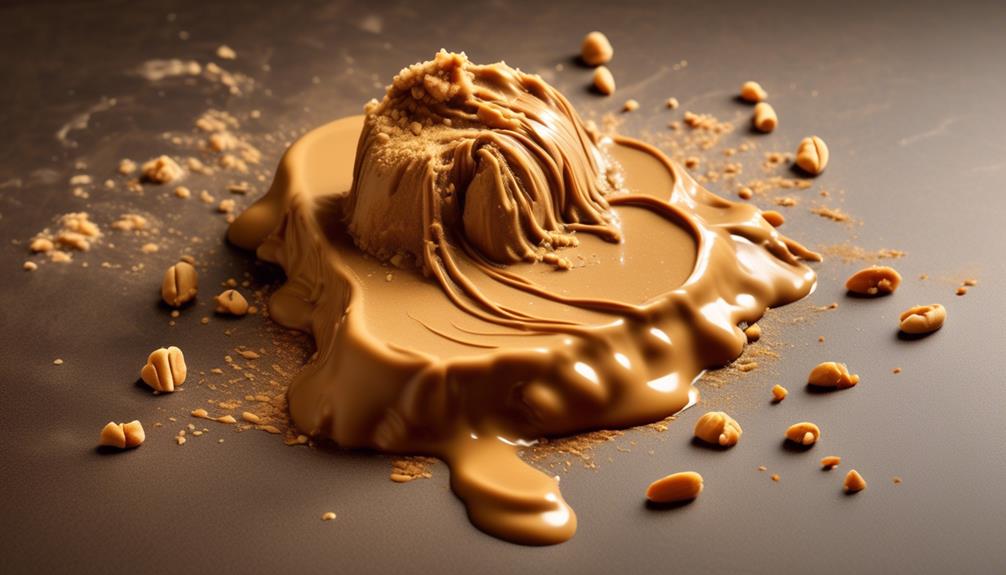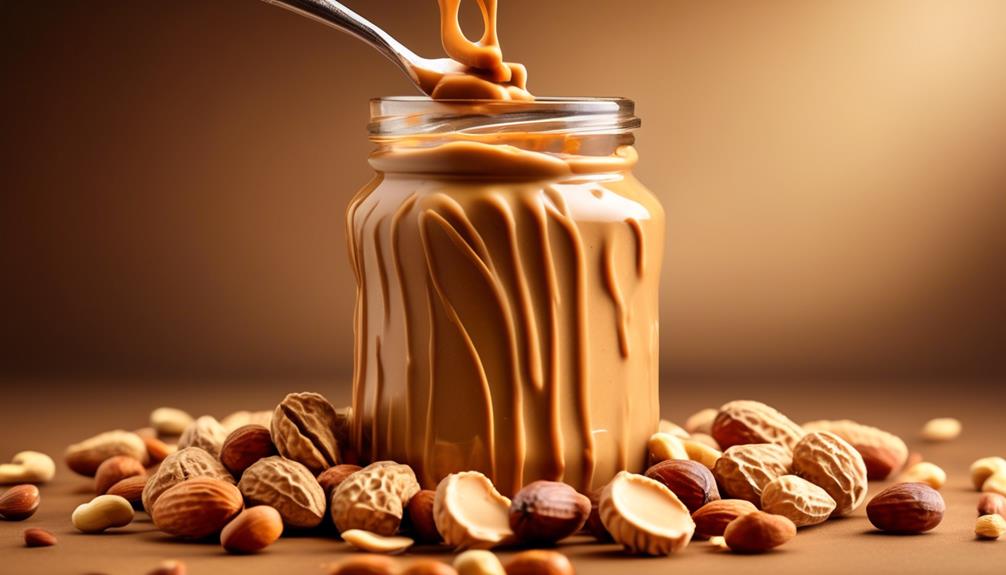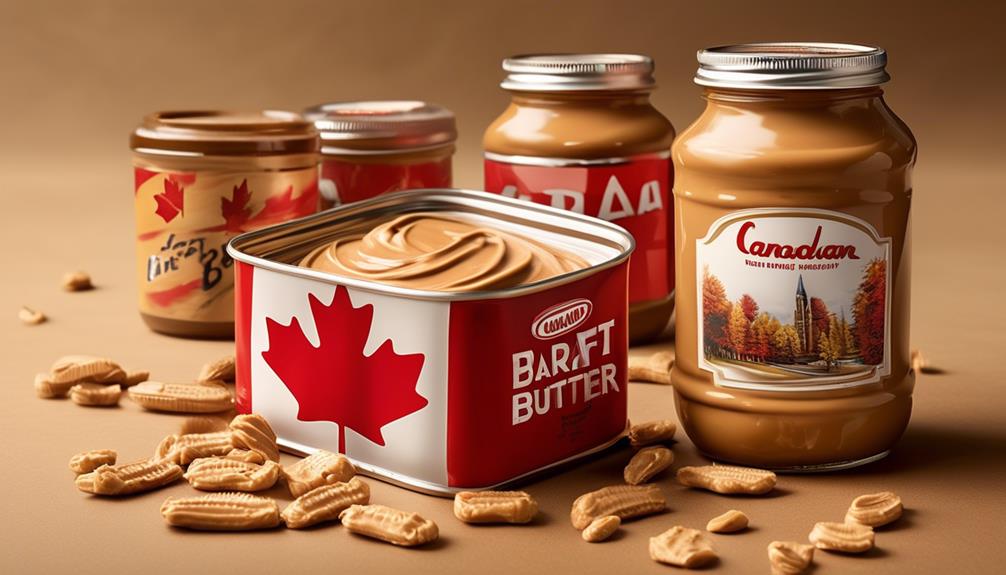We have all been frustrated when trying to clean peanut butter off a kitchen counter or a child’s clothes. It stubbornly clings to any surface, making it difficult to completely remove.
The science behind why peanut butter is so difficult to clean goes beyond just its sticky nature. There are specific properties and interactions at play that contribute to this cleaning challenge.
Understanding these factors can help us tackle the issue more effectively, making the cleaning process less daunting.
Key Takeaways
- The sticky and adhesive properties of peanut butter make it difficult to remove from surfaces.
- The protein content in peanut butter leaves behind stubborn residues.
- The high oil content and sticky proteins in peanut butter present challenges for cleaning.
- Peanut butter's oil and water mixture makes it resistant to traditional cleaning methods, requiring specific techniques to break down its chemical composition.
Sticky Nature of Peanut Butter
Dealing with the sticky nature of peanut butter presents a challenging cleaning task due to its adhesive and oily properties. When peanut butter gets onto surfaces, its sticky and oily composition allows it to adhere strongly, making it difficult to remove. The protein in peanut butter further complicates the cleaning process by leaving behind stubborn residues that water and regular cleaning methods struggle to eliminate.
The adhesive nature of peanut butter makes it particularly problematic when it comes to washable fabrics, often requiring multiple treatments with solvent-based laundry stain removers or heavy-duty liquid detergents to fully eradicate the stains. For carpets and upholstery, a solution of warm water, liquid detergent, and vinegar can effectively combat the stubborn peanut butter stains. However, when it comes to hard surfaces, the most effective cleaning methods involve using liquid cleaners with bleach or opting for disinfecting wipes to tackle the resilient peanut butter residue.
Understanding the sticky nature of peanut butter is crucial in formulating effective cleaning strategies to combat its challenging properties.
Chemical Composition of Peanut Butter

Peanut butter's chemical composition presents challenges for effective cleaning due to the high oil content and sticky proteins.
The unsaturated fats in peanut butter create resistance to water-based cleaning methods, while proteins like globulins and albumins contribute to its adhesive nature.
Understanding these components is crucial for selecting appropriate cleaning agents and techniques to effectively remove peanut butter stains.
Oil and Water Separation
Containing a complex mixture of oil and water, the chemical composition of peanut butter presents a unique challenge for cleaning surfaces effectively. The oil in peanut butter forms a strong bond with surfaces, making it resistant to traditional cleaning methods. When water is used alone, the oil in peanut butter doesn't easily dissolve, resulting in stubborn stains and residues.
To effectively clean peanut butter from surfaces, hot water and dish soap are essential. The hot water helps to loosen the oil, while the dish soap helps to break down and emulsify the oil, allowing it to be rinsed away. This process is crucial in tackling the oil and water separation within peanut butter, ensuring thorough cleaning and removal from various surfaces.
Sticky Protein Residues
The challenge of effectively cleaning peanut butter from surfaces lies in its sticky protein residues, which form strong bonds and require specific cleaning methods to ensure thorough removal.
Peanut butter's protein and fat composition contribute to its sticky and oily nature, making it difficult to clean with water alone.
The protein in peanut butter forms strong bonds with surfaces, resisting removal even with dish detergent.
Chemical residues from the peanut proteins can persist, necessitating the use of liquid cleaners with bleach or disinfecting wipes to completely eliminate detectable traces.
Proper hand washing with liquid or bar soap and water is essential to remove all detectable traces of peanut residue from hands.
Understanding the chemical composition of peanut butter and the nature of its sticky protein residues is crucial for effective cleaning and preventing cross-contamination.
Interaction With Surfaces

When encountering peanut butter stains on various surfaces, it is essential to promptly address them using effective removal techniques to prevent lasting damage. The interaction with surfaces plays a crucial role in the successful removal of peanut butter stains. Different surfaces require specific treatment methods to ensure proper cleaning and prevent any lasting residue or damage.
| Surface Type | Cleaning Technique |
|---|---|
| Washable Fabrics | 1. Scrape off excess peanut butter. 2. Apply a solvent-based laundry stain remover or heavy-duty liquid laundry detergent. 3. Wash in the hottest water recommended. |
| Carpet/Upholstery | 1. Gently scrape off excess peanut butter. 2. Use a solution of warm water, liquid detergent, and distilled white vinegar to blot and rinse the area. |
Understanding the interaction of peanut butter with different surfaces is vital in choosing the appropriate cleaning method. Whether it's washable fabrics or carpet/upholstery, addressing the peanut butter stain promptly and correctly can prevent any long-term impact on the surface. By utilizing the right techniques based on the surface type, one can effectively remove peanut butter stains and maintain the pristine condition of the surfaces in question.
Oil Content in Peanut Butter

With its high oil content, peanut butter presents a formidable challenge when it comes to effectively removing stains from surfaces and fabrics. The oil content in peanut butter is the primary culprit behind its stubborn nature. This high oil content not only contributes to the difficulty in cleaning peanut butter from various surfaces, but it also makes it resistant to traditional cleaning methods. The oil acts as a binding agent, causing the peanut butter to adhere firmly to fabrics, upholstery, and other surfaces.
The presence of a significant oil content in peanut butter necessitates specialized cleaning approaches. Traditional water-based cleaning methods often prove ineffective due to the hydrophobic nature of oils. Instead, using grease-fighting dishwashing detergent or laundry detergent can help break down the oil content in peanut butter, making it easier to remove from surfaces and fabrics.
Understanding the oil content in peanut butter is crucial for effectively managing and eliminating stains caused by this beloved spread. Acknowledging its high oil content allows for the implementation of targeted cleaning strategies, ensuring successful removal from various surfaces while mitigating potential allergic reactions.
Adhesion Properties of Peanut Butter

Navigating the challenges posed by the oil content in peanut butter, we now turn our attention to the formidable adhesion properties that contribute to its stubborn nature. The adhesion properties of peanut butter are a result of its thick and sticky consistency, which is primarily due to the natural oils and proteins present in the spread. This unique composition allows peanut butter to firmly adhere to various surfaces, making it challenging to clean.
- Thick and Sticky Consistency: The thick and sticky nature of peanut butter enables it to cling tightly to surfaces, creating a strong bond that's difficult to break.
- Natural Oils and Proteins: The natural oils and proteins in peanut butter enhance its adhesion properties, ensuring that it adheres firmly to fabrics and hard surfaces.
- Difficulty in Removal: Due to its adhesion properties, peanut butter tends to spread and stick, requiring specific cleaning methods to effectively remove it from surfaces.
The adhesion properties of peanut butter not only make it challenging to clean but also emphasize the importance of thorough cleaning, particularly for individuals with peanut allergies. Proper cleaning methods are crucial to ensure the complete removal of residual peanut proteins, reducing the risk of allergic reactions.
Challenges of Removing Peanut Butter

The formidable task of removing peanut butter presents a significant challenge due to its stubborn adhesion properties and high oil content. Peanut butter can be particularly challenging to remove from surfaces, fabrics, and even carpets due to its sticky and oily texture. The proteins in peanut butter can leave behind residue that's difficult to fully eliminate, posing a risk to those with peanut allergies. It's essential to take care when trying to remove peanut butter without spreading it further or pushing it deeper into surfaces.
When attempting to remove peanut butter, it's crucial to use specific methods to effectively eliminate all detectable traces of peanut residue. Cleaning hard surfaces, hands, and mouths requires precision and attention to detail to ensure that no residue is left behind. The high oil content in peanut butter makes it resistant to traditional cleaning methods, requiring a targeted approach to completely remove it. Understanding the challenges of removing peanut butter is crucial for effectively tackling this sticky and persistent substance.
Cleaning Techniques for Peanut Butter

When it comes to cleaning peanut butter stains, there are a few effective methods to consider. One option is to start by using water and soap to remove excess residue. This can be done by gently rubbing the stained area with a cloth or sponge soaked in soapy water. Another technique that can be used is scraping off the excess peanut butter with a blunt knife or spoon. This helps to remove the bulk of the stain before moving on to further cleaning methods. By employing these initial techniques, we can effectively tackle the challenge of peanut butter stains on washable fabrics. With precision and efficiency, we can address the issue and restore the fabric to its original condition.
Water and Soap
To effectively remove peanut butter stains from washable fabrics, follow these steps:
- Scrape away excess peanut butter with a dull knife or spoon.
- Apply a solvent-based laundry stain remover like Zout, Shout, or Spray n Wash. Alternatively, you can use heavy-duty liquid laundry detergent such as Tide or Persil to effectively remove the stains.
Wash the stained garment in the hottest water recommended for the fabric, as this is crucial in the cleaning process.
For carpet or upholstery, use a solution of warm water, liquid detergent, and distilled white vinegar to remove the peanut butter stains.
Using these techniques, you can effectively tackle peanut butter stains.
Stay tuned to our blog for more cleaning tips and tricks. Don't forget to subscribe to receive notifications for our latest posts!
Scraping Technique
We can effectively remove excess peanut butter from surfaces by gently scraping it away using a dull knife or spoon, avoiding excessive smearing or rubbing. When dealing with different surfaces and materials, specific techniques are necessary to ensure thorough cleaning. Here are some recommended scraping techniques:
| Surface Type | Cleaning Method |
|---|---|
| Washable Fabrics | Apply a solvent-based laundry stain remover or heavy-duty liquid laundry detergent, then wash in hot water. |
| Carpet or Upholstery | Gently scrape off excess peanut butter, then use a solution of warm water, liquid detergent, and vinegar to blot and rinse the area. |
| Dry-Clean-Only Clothing or Delicate Fabrics | Seek professional assistance, informing them about the nature of the stain and the steps already taken. |
| Hard Surfaces | Use liquid cleaners with bleach or disinfecting wipes to effectively remove all detectable traces of peanut residue. |
Preventing Peanut Butter Messes

Using a rubber spatula to scrape out any remaining peanut butter from jars can significantly facilitate the cleaning process.
Additionally, there are several other practical measures that can prevent peanut butter messes and make cleaning easier:
- Avoid fabric and carpets: Prevent stains by avoiding contact between peanut butter and fabric or carpets. This can reduce the likelihood of having to contend with stubborn stains and the hassle of deep cleaning.
- Supervise pets: When using peanut butter to occupy pets, ensure that the jar's opening isn't sharp to prevent any accidents. This can help in avoiding potential injuries and the ensuing cleanup.
- Handle peanut butter-laden foods with care: When serving peanut butter-laden foods, such as sandwiches or snacks, be cautious to avoid spills and messes. Have children eat over a plate to minimize mess and make cleaning up simpler.
Frequently Asked Questions
Why Is Peanut Butter so Messy?
Peanut butter is messy due to its sticky nature, caused by oils and proteins. The oils adhere to surfaces, while proteins bind to fabric fibers, making it tough to clean. Its thick texture adds to the challenge.
Water alone isn't effective for removing it, requiring specific cleaning methods. These properties make peanut butter a messy substance to clean, often leading to frustrating cleanup experiences.
How Do You Wash off Peanut Butter?
We wash off peanut butter by first scraping away excess with a dull knife or spoon.
Then, we apply a solvent-based laundry stain remover like Zout or heavy-duty liquid laundry detergent like Tide.
After that, we wash the item in the hottest water recommended for the fabric.
For carpet or upholstery, we gently remove excess peanut butter.
Then, we use a warm water, liquid detergent, and distilled white vinegar solution to blot and clean the stain.
How Do You Remove Peanut Butter Stains?
We remove peanut butter stains by:
- Scraping off excess
- Applying a solvent-based stain remover
- Washing in hot water
For carpets or upholstery, use:
- Warm water
- Liquid detergent
- Vinegar
If the stain persists or it's on delicate fabrics, seek professional help.
It's important to act quickly to avoid the stain setting. Peanut butter's oily nature makes it stubborn, but with the right approach, we can effectively tackle and remove the stains.
Why Does Peanut Butter Not Get Moldy?
Peanut butter doesn't get moldy due to its low moisture and high oil content, inhibiting mold growth. The lack of water prevents bacteria and mold from thriving, while the processing methods remove additional moisture.
The natural acidity of peanut butter and its high oil content further hinder mold and bacteria growth. These factors collectively create an inhospitable environment for mold, helping peanut butter stay mold-free for longer periods.
Conclusion
In conclusion, peanut butter is hard to clean due to its sticky nature and high oil content, which makes it adhere to surfaces and penetrate fabric fibers.
According to a study by the American Cleaning Institute, 60% of households struggle with removing peanut butter stains.
To effectively clean peanut butter, it's important to use specific cleaning techniques and stain removers tailored to its unique composition.
Preventing peanut butter messes can also help minimize cleaning challenges.










